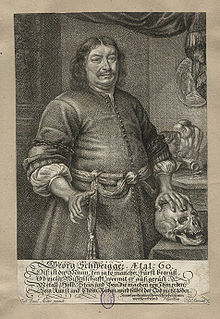Georg Schweigger


Georg Schweigger (born April 6, 1613 in Nuremberg ; † June 13, 1690 ibid), son of Emanuel Schweigger and grandson of Salomon Schweigger , was a German sculptor, sculptor and medalist of the Baroque , who was especially known for his small-format works from Solnhofen stone , carved wood and cast metal was known. Schweigger's only large-scale sculpture was the Nuremberg Neptune Fountain , which had been in Petersburg since 1797 and which he co-authored with Christoph Ritter .
Life and meaning for the development of the baroque
Schweiggers work must be classified as very innovative and independent for its time. Its theme is movement. It is consistently shown in his sculptures, especially in the group of figures in the Neptune Fountain. His figures are never static or at rest, but always dynamic, as if captured by chance at the moment of movement. Groups of figures are staged almost dramatically and sometimes in extreme movement. He himself said that his characters were all formed from life. Schweigger actually modeled his sculptures on living models. " A beautiful and long " (note: slim) " virgin paid Schweigger '20 Reichsthaler to put up her bare body and thus gradually got a large number of different women ' "
Schweigger, who was also 'successful' in a business sense, worked for clients throughout Central and Northern Europe. In the baroque period he was considered to be a strong representative of the carpe diem , i.e. the sensual and life-affirming side of the baroque period. He evidently embodied this himself in his lifestyle, because Schweigger " remained a bachelor and was known for his corpulence ".
In Schweiggers workshop are also said to have been made of steel army drums and light but bulletproof armor in 1670 for Elector Friedrich Wilhelm of Brandenburg and in 1688 for Elector Johann Georg IV of Saxony.
After his death, Jeremias Eißler continued to run the workshop in the spirit of his teacher. Schweigger is buried in an honorary grave from the Baroque period (No. 540) in the Sankt-Johannis-Friedhof in Nuremberg.
The works in his collection by Schweigger, who is largely unknown in Germany today - although he must be regarded as one of the most important artists and one of the pioneers of the Baroque in Central and Northern Europe - is rated by the British Museum as "an outstanding work" , which is why he has been copied many times.
Works


- Bust of Emperor Ferdinand III, bronze sculpture, Kunsthistorisches Museum
- Schwanhardt epitaph in the Johannisfriedhof in Nuremberg (1654, preserved)
- Sermon of John the Baptist, relief made of Solnhofer stone (20 × 13.8 cm), ibid, (British Museum, London)
- Christ on the cross, carved wood (30 × 29 cm), ibid
- Neptune Fountain , 1652–1660, bronze, Peterhof Palace near St. Petersburg (second casting in Nuremberg )
- Crucifix for the Kastor Church in Koblenz, 1652.
- Schwanhardt epitaph in the Johannisfriedhof in Nuremberg, bronze, 1654.
- Sculptural jewelry for the Ehrenpforte on the occasion of Emperor Leopold's entry into Nuremberg, 1658
- Salvator Christ in St. Sebald, Nuremberg
- Tucher altar in St. Sebald, Nuremberg, bronze, 1659
literature
- Ernst Friedrich Bange: Contributions to Georg Schweigger. Two designs for monuments to Gustav Adolf . In: Yearbook of the Prussian Art Collections, Volume 52 (1931), pp. 107–111
- Annette Kranz: To the portrait medallion on Willibald Pirckheimer by Georg Schweigger. A study of two new acquisitions by the State Coin Collection in Munich . In: Yearbook for Numismatics and Monetary History . Vol. 51/52 (2001/02), pp. 125-143
- Paul Johannes Rée: Schweigger, Georg . In: Allgemeine Deutsche Biographie (ADB). Volume 33, Duncker & Humblot, Leipzig 1891, pp. 333-335.
- Margarete Schuster: Georg Schweigger. A 17th century Nuremberg sculptor . Dissertation, University of Vienna 1966
- Manfred H. Grieb (Hrsg.): Nürnberger Künstlerlexikon: Fine artists, craftsmen, scholars, collectors, cultural workers and patrons, from the 12th to the middle of the 20th century, Vol. 3, (Nuremberg / Munich 2007)
- Hans Robert Weihrauch: Georg Schweigger (1613-1690) and his Neptune Fountain for Nuremberg , Anzeiger des Germanisches Nationalmuseum 1940–1953, Berlin, 1954, pp. 87–143
- Claudia Maué: The tomb of Johann Schlütter by Johann Carl and Georg Schweiggers first portrait bust . In: Rainer Kahsnitz , Peter Volk (Hrsg.): Sculpture in Southern Germany. Festschrift for Alfred Schädler. Munich - Berlin 1998, pp. 241-272
Web links
Individual evidence
- ↑ a b Erich Mulzer: Neptuns Irrfahrten , in Altstadt reports No. 13/1988, Nuremberg 1988.
- ↑ Schweigger himself, quoted in: Erich Mulzer: Neptuns Irrfahrten , in Altstadt reports No. 13/1988, Nuremberg 1988.
- ^ British Museum / www.britishmuseum.org/explore/highlights/highlight_objects/pe_mla/g/georg_schweigger,_the_birth_an.aspx
| personal data | |
|---|---|
| SURNAME | Schweigger, Georg |
| ALTERNATIVE NAMES | Schweiger, Jörg; Schweiger, Georg; Schweikard, Georg |
| BRIEF DESCRIPTION | German sculptor, sculptor and medalist |
| DATE OF BIRTH | April 6, 1613 |
| PLACE OF BIRTH | Nuremberg |
| DATE OF DEATH | June 13, 1690 |
| Place of death | Nuremberg |
